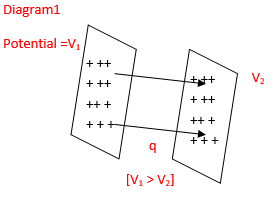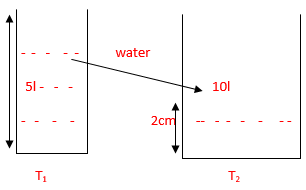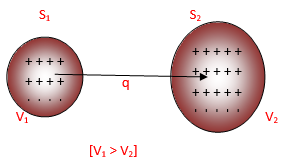Common Potential in Combination Capacitor
Description:
Whenever two capacitor/ conductor carrying different potential are connected, then irrespective of number of charges contained by the conductors, flow of charge always takes place from higher potential to lower potential. So, potential across the conductor is the deciding criteria for charges to flow.

This concept can be understood more clearly, with the help of an analogy. Let there be two tanks T1 and T2 where T1 is a narrow tank as compared to T2. Let T1 contains 5 litres of water and the level of water in the tank is marked as 5 cm. Similarly T2 contains 10 litres of water such that water level is raised the by 2 cm.
If tanks are connected together, even though the volume of water in T2 is more than in T1, still water will flow from tank T1 to T2 as the height of water in T1 is greater than in T2. So, height of water within the tank is the deciding criteria for the direction of flow. The flow will stop when water level of both the tank becomes equal.

Height of T1 > T2
Direction of flow is T1 to T2
Similarly, potential of a conductor is the deciding criteria for direction of flow of charges.
Potential − Potential of a conductor is the total amount of work done in moving a unit charge within conductor.
Let there be two conducting spheres (S1 and S2) having different potentials V1 and V2 respectively, such that r < R. Let the charge carried by them be ‘Q and 2Q’. Let the density of charge within S1 be much more than that in S2. So, the charges ’Q’ within S1 will experience the greater tension than charges within S2. If an additional unit charge ‘q’ is tried to be inserted within each conductors, then, charge q will experience a greater repulsion due to charges in S1 than charges in S2. even though the charges within S2 is more, still work done against the force of repulsion due to charge within S1 will be more. So, the potential of sphere S1 will be more than S2. So, V1 will be greater than V2. If S1 and S2 are connected, then charge will start flowing from S1 to S2, i.e from higher potential to lover potential. The flow of charge will stop when both reach a common potential.

Charge in S1 = Q
Charge in S2 = 2Q
If C1, V1 and q1 are the capacitance, voltage and charge carried by S1.
C2, V2 and q2 are the capacitance, voltage and charge carried by S2.
Then the common potential for S1 and S2 will be :
total charge q = q1 + q2
we know that, q1 = C1 V1 and q2 = C2V2
q = C1 V1 + C2V2
Total capacitance C = C1 + C2
Note
- When two charged bodies are connected, charge always flows from higher potential to lower potential.
- Charge flows till both the bodies reach a common potential.

